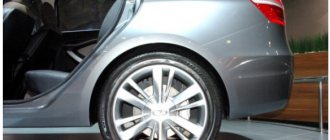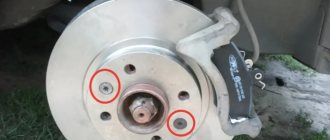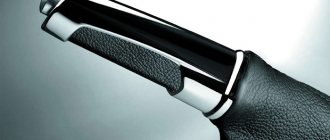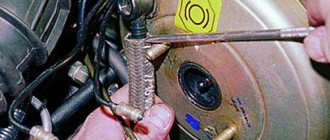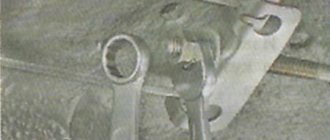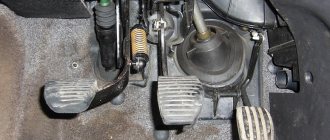Drums, of course, long ago lost the evolutionary war to discs, but to this day they are quite actively used on inexpensive and lightweight machines. All Ladas, Renault Logan, VW Polo sedan, Skoda Rapid, Daewoo Matiz - the list of completely modern models using these archaic but durable brake mechanisms will be very long. This means it’s useful to know how they work, why they break and how they are repaired. After theoretical preparation, we will go to the repair zone, where we will examine the drums of a rare Chinese sedan Chery Jaggi, better known in Russia under the name QQ.
Device
The rear drum brakes are shown in the picture below. This type of brake mechanism has a drum as a rotating element. In the fixed part there is a support shield and pads.
In the figure, elements 1 and 3 are stationary, and element 2 rotates.
This type of brake device includes:
- A drum that is attached to the wheel hub;
- Pads with linings;
- Brake working cylinder, which has 2 pistons with cuffs and boots;
- There is also a fitting screwed into it, with the help of which the liquid is pumped;
- Compression (return) springs that cling to the pads and hold them in the desired position;
- Brake support plate attached to the bridge beam;
- Stand support pads;
- The lower support for the pads with adjustment is an adjustment of the rear pads, allowing you to set the desired gap between the drum and the pad so that the brakes work well and at the same time they do not touch when it is not necessary;
- Brake fluid mechanism;
In addition to standard devices with one cylinder, as in the photo above, there are mechanisms with two cylinders.
Their effectiveness is recognized to be higher than the first option. The principle of operation of drum brakes with two cylinders is the same, only a second cylinder is installed instead of the lower support. In such a mechanism, the surface area of contact between the shoe and the drum is larger, which means the braking is stronger.
Caring for the drum brake system
The main elements of the device are pads and brake cylinders. The main concern of the car owner is the timely replacement of worn-out friction elements, inspection and repair of damaged brake parts, adjusting the gaps inside the drum and adjusting the parking brake.
The need to replace the pads is indicated by their thinning to a critical level of 0.8-1.6 mm. A special service hole located on the inside of the shield will help determine the degree of wear.
If the brake cylinder does not visually show any signs of leaks or wear on the cuffs, then you can check its operation by simply pressing the right and left pads. Both are moving, which means the shopping center is fine.
In the event of a brake fluid leak and/or air in the hydraulic system, the brake pedal may become soft and “sink.” In this case, it is necessary to bleed the brakes.
Principle of operation
Here's how these devices work: Brake fluid, after the driver presses the brake pedal, flows from the master cylinder to the working cylinders, squeezing out their pistons. These pistons extend and force the pads against the drum. Thereby reducing its rotation and stopping the wheels. This will happen due to friction of the linings on the surface of the drum. After the pressure on the brake pedal stops, the pads are pulled back by springs. And the braking stops. Fluid from the slave cylinders is pushed back into the master cylinder. The wear of the pads will be uneven on the front and rear wheels, which should be taken into account when replacing.
basic information
Any car, both small and large, must be equipped with a braking system. The main task of the braking system is to change the speed of movement of vehicles, at the command of the car owner or the electronic guidance system. The second purpose of the braking system is to keep the car stationary in relation to the road while it is parked.
Depending on the design of the friction part, a distinction is made between disc and brake drum mechanisms. The braking mechanism has a fixed and rotating part. The role of the moving part of the drum braking structure is played by the stopping drum, and not by the rotating band or braking pad. The moving part of the brake disc design has the form of a disk, and is not rotated by the brake pads. The axles of modern passenger cars usually have a disc braking structure.
Drum brake diagram
The disc braking mechanism consists of the following elements:
- Brake disc;
- Two non-rotating pads that are installed in the middle of the caliper on both sides.
Let's look at the main advantages and disadvantages of drum and disc brakes. So, the advantages of drum brakes:
- Long service life, since dirt and dust do not penetrate into the drum;
- Greater braking effort, which is good for trucks;
- Not an expensive repair kit.
Disadvantages include:
- Slowness;
- Pads sticking.
Advantages of disc brakes:
- Greater braking efficiency;
- Small mass;
- Small sizes;
- Low brake fluid temperature;
- High level of reliability;
- Stability.
The only drawback is poor protection from dirt and dust.
What is the principle of operation of the braking system?
Let's look at the principle of operation of the braking system using the example of a hydraulic operating unit. When the brake is pressed, the load is transferred to the amplifier, which creates additional reinforcement on the main cylinder. The piston of the main brake cylinder collects all the fluid in the car wheel cylinders using pipelines. Moreover, at the same moment, the fluid pressure in the brake drive increases. Thanks to the pistons of the car wheel cylinders, the brake pads move to the discs, or as they are also called drums.
After pressing the brake, the fluid pressure increases, as a result of which the braking mechanisms are activated, causing the rotation of the car wheels to slow down and generate braking force at the point of contact of the car tires with the road surface.
Moreover, the more force is applied to the brake pedal, the more efficiently and quickly the car wheels will stop. The liquid pressure at the moment of stopping can reach from ten to fifteen megapascals.
At the end of braking, the pedal moves to the reverse position under the influence of the return spring. The piston of the main braking cylinder also switches to the reverse position. Parts of the springs are retracted from the drums using blocks. Brake fluid passes into the main braking cylinder from the car wheel cylinders thanks to pipelines. Thus, the pressure of the braking system decreases.
Drum brakes squeak
To eliminate the squeaking of rear drum brakes, you need to purchase a suitable repair kit. So, what repair kit should you buy if your drum brakes squeak?
- Anti-recoil struts;
- Set of socket heads;
- Coarse-grained skin;
- Hammer;
- Balloon wrench;
- Torque wrench;
- Screwdriver;
- Support stands;
- Jack.
So, what should you do if your drum brakes squeak?
- First of all, prepare the repair kit;
- Place the car on a flat surface and remove the parking brake;
- Place wheel chocks under the car wheels;
- Loosen the bolts securing the car wheels;
- Place the car on a jack;
- Remove the wheel;
- Carefully remove the protective cap that covers the wheel bearing. To do this you will need a screwdriver and a hammer.
- Unscrew the nut that secures the drum;
- Remove the drum;
- Using coarse sandpaper, remove the edge created by the functioning of the pads;
- Clean the drum from rust;
- Install everything in reverse order. Use a torque wrench when tightening the bearings.
- Check if the rear brakes are squealing.
We recommend: Crankshaft bearings - what are they?
Algorithm for replacing rear drum brakes with disc brakes
Before you proceed to replacing the rear drum brakes, you need to purchase a repair kit. So, how do you replace brakes with disc brakes?
- First, we prepare the repair kit;
- Raise the back side of the car on a jack;
- Remove the corresponding wheel;
- Release the handbrake;
- Mark the location of the drum and hubs;
- Insert 2 screwdrivers into the holes of the brake flap;
- We clean the brakes using a special fluid;
- Remove the return spring from above in front of the block;
- Remove the spring plate that secures the block. To do this, you need to press the plate and rotate it ninety degrees.
- Remove the block and the adjusting bar;
- Disconnect the handbrake cable from the rear shoe lever;
- Remove the adjusting bar spring;
- Disconnect the return spring;
- Remove the adjusting bar;
- Remove the bracket that secures the pad;
- Remove the adjusting lever;
- Remove the handbrake lever;
- We install new parts, doing everything in reverse order;
- We install the wheel on the vehicle.
Advantages and disadvantages
This device has its pros and cons. Let's start with the cons:
- It has been proven that the braking efficiency of this type of mechanism is slightly lower than that of disc mechanisms. The braking distance is almost 20% longer. This is due to the following reasons: insufficient contact area, which is not provided even by two cylinders, and the resulting slipping, which is caused by dust that has penetrated into the mechanism.
- Overheating of the drums due to lack of cooling; when braking, the temperature of the drums can rise to 6000 degrees.
- A reduced maximum load value, at high pressure, can rupture the drums with liquid pressure.
However, not everything is so bad; there are also undeniable advantages of this mechanism:
- The closed design allows you to get good braking force, and you can increase the friction surface by making the drum wider and the pads too. This is what ensured the widespread use of such a mechanism on all trucks and buses.
- The degree of resistance to wear and the service life of the linings is increased, which is caused by less frictional contact than with a disc brake.
- Good protection against dirt getting inside, which the disk version does not have.
I won’t say whether disc or drum brakes are better; passenger cars mostly have disc brakes, but they are not suitable for buses and trucks.
Advantages and disadvantages of drum brakes
Drum brakes are easy to manufacture and lower cost compared to disc brakes. They are also more effective due to the larger contact area between the pad and the drum, as well as due to the “wedging” effect of the pads: due to the fact that the lower parts of the pads are connected to each other, friction against the drum of the front pad increases the pressure on it from the rear.
Are there any disadvantages to drum brakes? Compared to disc brakes, drum brakes have more weight, poorer cooling and braking instability when water or dirt gets into the drum. These shortcomings are very significant, so they served as one of the reasons for the transition of manufacturers to disk mechanisms.
Differences
How are disc brakes different from drum brakes? The main difference is the braking element; in disc models it is a disc, in drum models it is obviously a drum. The device is also different, the disc brake has a special brake caliper, and the drum brake has a brake cylinder. The pads used are also different. In a drum they expand, pressing against it, but in a disk they compress and clamp the disk. Which works better? To understand this you need to become at least a mechanic or brake tester.
Both mechanisms have their pros and cons, but both are still quite effective, otherwise they would have been abandoned long ago.
Signs of trouble
If these signs appear, you should check the condition of the entire brake system:
- When braking, the vehicle pulls to the side, which means a malfunction of one of the braking mechanisms.
- The creaking of the rear mechanisms can be caused by the separation of the linings from the pads, deformation or breakage of the springs, as a result of which the pads are skewed.
- It is possible for the clamps to jump off the supporting posts; squeaks are caused by them getting between the drum and the pad linings.
- The appearance of jerking or vibration of the pedal when braking is caused by deformation of the drum.
Tips for use
Car care includes periodic inspection of important components and mechanisms of the vehicle. The brake system is one of the most important; its inspection for wear and possible malfunctions is mandatory.
Every 20 thousand km you should check the pads, springs, levers, etc., measure the brake fluid level, check the condition of the cylinders, seals and pipes for integrity and possible leaks.
When installing new pads, experts advise “rolling in” them:
- Find an empty section of road.
- Accelerate to the permitted city speed and slow down to 10 km/h, repeat the acceleration and reduce the speed at least 10 times. At the end of the procedure, drive another 5 km at a calm pace.
Malfunctions
There are seven main problems:
- Worn drum or pads. The most dangerous thing will be the simultaneous wear of these parts, then the wheel can simply block tightly. If there is slight wear on the drum walls, a groove is needed to grind off the sides and level the surface. After this, the pad tension system should be adjusted. They are replaced when:
- For glued ones, the thickness of the friction layer reached 1.6 millimeters.
- For riveted linings, wear reaches 0.8 millimeters from the rivet. Warping of the pads is a fairly common cause of damage to the drum, its uneven grinding, as a result of which it has to be replaced.
- Springs, struts or spacers break.
- Cable rupture or handbrake lever breaking off
- Peeling of linings from pads
- Destruction of the cuff, scuffing of the cylinder, rupture of the hose, depressurization of the pipeline, resulting in fluid leakage from the system and its airing. Brake failures occur.
- Corrosion of springs, resulting in them not working as expected.
To avoid troubles associated with brake system malfunctions, it is recommended:
Check the condition of the linings every 20 thousand mileage, change if necessary; buy a repair kit for the rear pads in the store. Here it is important not to make a mistake with the brand and model, the similarity is confusing, so it is better to have old pads with you for a sample. Pay attention to drips and stains on the ground where your car was parked. Watch the brake fluid level inside the reservoir on the master cylinder.
Drum brake service
Checking the thickness of the brake lining
The wear of the drum brake pads can be determined through a special hole located on the inside of the brake shield. When the friction linings reach a certain thickness, the pads need to be replaced.
If the friction material is applied to the pad using glue, then it is recommended to change it when the material thickness is 1.6 mm. If friction linings are placed on rivets, replacement must be made if the material thickness is 0.8 mm.
Worn pads can leave grooves on the drums and, with prolonged use, even damage the drum.
Replacement with disk
Many experts, including myself, say that replacing drum brakes with disc brakes is associated with a large number of problems:
- The first problem is adapting the hand brake mechanism to the disc mechanism. The design is too different, so connecting the old manual brakes to the new ones will not work. There are two solutions here - either figure out how to remake the old mechanism so that it works, or install a new one. The first option can only be performed by a mechanic with extensive work experience, and not everyone will undertake it. The second option is simpler and more accessible, but its cost is not small. You simply purchase and install a hydraulic handbrake on new mechanisms.
- The second problem is choosing a mechanism suitable for replacement with the required dimensions and to effectively cope with braking. So that there is no difference in diameter or studs. Why buy brakes that won't fit or will work worse than what you had? At the same time, you should not forget to demand quality certificates for purchased mechanisms. This is the only way to be sure that these are reliable branded parts.
- The third problem arises after replacing mechanisms. The fact is that any design changes in the car that affect control and so on must be included in the technical data sheet and the insurance document for the car. This is the only way you can avoid fines and other troubles from the traffic police and misunderstandings among the mechanics who will have to service your car.
- Fourth and most difficult, you may be denied registration of a vehicle if they consider that after modernization the machine no longer meets safety standards or the requirements of operating regulations. Therefore, first find out whether such a change in the design of your car can be registered, and then start thinking about how to change drum brakes to disc brakes.
If you don’t mind your nerves, money and time, you can get started, no one is stopping you.
These are all friends, subscribe to updates if you haven’t already and share the information with your friends via the link, it won’t hurt for them to subscribe either, see you.
Production history
And they were invented back in the 19th century. The first prototypes of modern brakes were a primitive system of only three components. This was the brake drum itself, attached to the wheel, a strong and flexible band located around it, as well as a lever that tensioned the last part. Naturally, the service life of such a system was short-lived, and various stones and dirt got into it.
The design was improved only at the beginning of the 20th century. Then engineer Louis Renault invented a new brake drum with more reliable components. For the first time, it included pads located inside the mechanism. The brake device was well protected from dirt, and therefore its service life increased significantly. Since then, the brake drum has repeatedly changed its design and materials, but its function has remained unchanged. Such a device still reduced the vehicle's speed when necessary. It also served as a hand brake.
